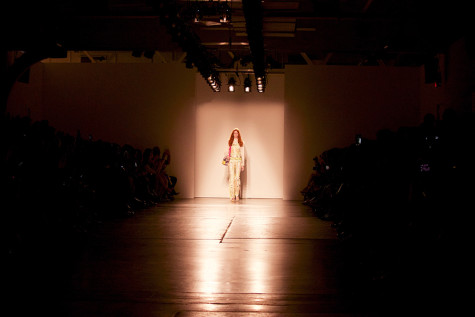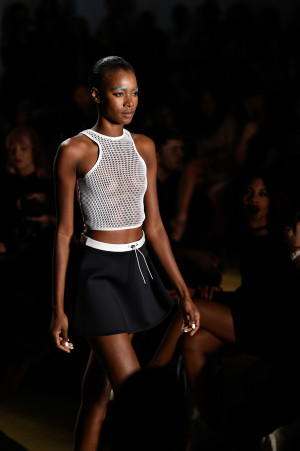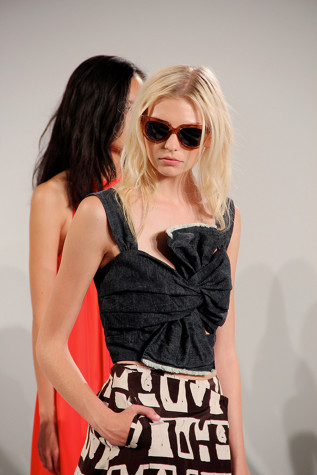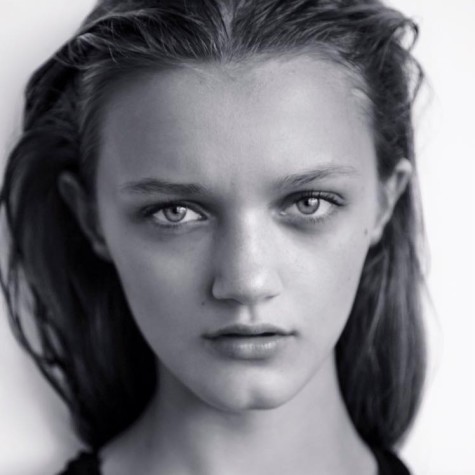The Fashion Week Issue
September 21, 2015
WSN had the unique opportunity to attend one of the best fashion events in the world, New York Fashion Week. Check out our recap below, or for individual show reviews, go to our Beauty & Style section or our style blog Violet Vision.
The Evolution of Fashion Week

Custo Barcelona at New York Fashion Week.
Only one event has New York buzzing with an influx of models, sartorial street style and an economic impact of $865 million each year: New York Fashion Week. While France may be able to boast that it originated fashion parades in which haute couture salons showcased their wares, it is New York City that claims the title as birthplace of is the runway show.
The 1903 Ehrlich Brothers’ fashion show is commonly believed to be the world’s first fashion runway show. Friendly competition against the Parisians prompted Eleanor Lambert, a prominent fashion publicist, to organize a so-called “Fashion Press Week” in 1943 New York, the earliest predecessor to the current NYFW. This event allowed designers to display their collections to journalists and editors. Fashion magazines that once predominantly featured European designers, such as Vogue, began to feature more American designs.
Continuing from Lambert’s first week of shows in the early ’40s, NYFW has since transformed into a city-wide event. After countless relocating and renaming, from “7th on Sixth” at Bryant Park to “Mercedes-Benz Fashion Week” at Lincoln Center, the week has now evolved into a decentralized schedule of events, aptly titled “New York Fashion Week: the Shows.”
However, the technical and logistical changes of NYFW were not the only alterations. The overall purpose and tone of NYFW seems to have changed. Fashion week was once was an exclusive, invite-only event for industry insiders. However, with the advent of the Internet and social media, everyone can now be part of the audience.
The year 2009 was the watershed year for livestreaming Fashion Week, with Alexander McQueen livestreaming its Spring/Summer 2010 show. Others in the fashion industry quickly followed suit, with Louis Vuitton, Alexander Wang, Marc Jacobs and Burberry also streaming their runway shows. In 2015, it is no longer just the business elite who watch these shows.
While 100,000 people attended Fashion Week 2014, 2.6 million people livestreamed the shows, watching Fashion Week from the comfort of their own screens. Guest lists still exist; however, they are now nearing irrelevance. Why trek out in the rain if you can see the best show, and probably have a better view, if you stay at home and stream the show? You can live in Kansas, Taipei, New York — anywhere you have access to your preferred Internet platform, and have access to Fashion Week and the newest collections.
This year’s hottest show, Givenchy, opened its doors to the public but with a catch. Creative director Riccardo Tisci allowed 820 lucky members of the public to win coveted tickets to his 10th anniversary show for the legendary French house. While there was a separate entrance for the public, there was a precedent set: the exclusivity of Fashion Week is changing. If a haute couture house has allowed the public into its show, what’s next?
Fashion has become a more egalitarian, collaborative process; however, not everyone is happy with this evolution of NYFW. In 2013, New York Times reporter Eric Wilson said, “The real point of Fashion Week, to promote collections to editors and retailers … is becoming lost in the age of instant online accessibility … Fashion Week is losing its relevance.”
While the changing guest list may seem to make Fashion Week extraneous, the overall meaning of Fashion Week is changing to combat this. Fashion Week has become a public platform for social justice and artistic statements alongside being an excellent marketing and publicity event. Everyone watched in awe as Riccardo Tisci and Marina Abromavic’s hauntingly memorable runway show exhibited Tisci’s works of visual art with Abromavic’s passionate performance tableaus on Sept. 11.
Designer Kerby Jean-Raymond’s Spring/Summer 2016 NYFW runway show combined video, clothing and live art to protest police brutality. A 10-minute video depicted the killing of Walter Scott, the unarmed man shot by police officers in South Carolina. Immediately following the Scott footage, Jean-Raymond presented footage of the Texas teens terrorized by police this summer. This powerful display ended with Eric Garner’s infamous last words “I can’t breathe.” The collection furthered Jean-Raymond’s protest against America’s codification of racism; gunshots replaced bass drops, models strutted while splattered in blood and Eric Garner’s “I can’t breathe” was hand-graffitied on-site on each shoe.
From its origins in the early 20th century, NYFW has continued to evolve, reflecting the styles we as a society find captivating. It is in this sustained growth that the city-wide event and its runway shows are again finding their role as a space of even more reflection for society.
Email Linda Yang at [email protected].
Style Trends

Black and White
Even with a wide array of spring hues to choose from, a plethora of designers chose to go with black and white this season. Brands including Givenchy, Public School and DKNY all agreed on the fact that the simplest colors have the biggest impact.
Pleats
Schoolgirl fashion is back. Thom Browne, J. Mendel and Public School dominated their collection with unique pleats, proving to the public that they can be creative in different cuts and colors.
Free Shoulders
No one was afraid to show off their shoulders this season. Calvin Klein, Derek Lam and Victoria Beckham included bare shoulder dresses and tops. Make sure to put sunscreen on those shoulders to avoid odd tan-lines though.
Sequins
Shining brighter than any accessories this season, sequins dominated the skirts and dresses at Marc Jacobs and accessories at J Crew.
Floral
Spotlights for the best floral pieces were seen in Diane Von Furstenberg’s billowing silk blouses, Calvin Klein’s crisp coats and at 3.1 Philip Lim in sporty streetwear.
Fringe
Ohne Titel, Anna Sui and Alexander Wang showcased stunning fringe pieces during NYFW. Their use of fringe deviated from the norm, using out of the box designs including chains and leather. Designers proved that fringes are no longer just for hippies.
Stripes
Ralph Lauren, Public School and Alexander Wang used stripes of all different varieties. Lauren’s pieces emphasized elegance while Public School’s stripe pieces had more of a casual street look in wide pants and boxy button-ups. Wang’s vertical and horizontal stripes held a similar high street look.
Robes
Robes are not something you simply put on after a shower. Givenchy and Thakoon Addition challenged that norm with their takes on the luxury loungewear.
Email Adryan Son at [email protected].
Beauty Trends

Whit presentation at Pier 59.
One of the most anticipated events of the year, New York Fashion Week is recognized as the national trendsetter for upcoming seasonal fashions. This year, the Spring/Summer 2016 collections sported many new beauty trends, along with expanding upon a few of last season’s fads.
Sleek Buns
Recognized as a look of clean sophistication, the slicked back hairstyle’s sense of neatness purposely draws attention to facial features. The versatility of this look, whether paired with Supima’s elegant evening gowns or Chromat’s high-intensity sportswear, provides practicality.
Cut-Outs
Designers like Katie Gallagher and Mara Hoffman included these negative spaces in a variety of looks ranging from swimsuits to blouses to evening wear. Adding a cutout to a sophisticated look creates a playful, attention-grabbing edge while not exposing too much skin.
Open-Backs
Distant cousin of the “cut-out trend,” the bold open-back was the focal point of a variety of this season’s dresses and gowns. A “v” shape extending to the lower back characterized Ji Oh’s floor length navy dress while a similar lace-lined open back added edge to Rita Vinieris’ lace and tulle black gown.
Fur Accents and Accessories
Perhaps rather ironically, the warmth of a fur hairband coupled with the coolness of a flowy, silk dress created a visually interesting contrast at Katie Gallagher and Georgine.
Natural, Well-Hydrated Skin
Although some designers like Barbara Tfank chose to add small pops of lip color or play with a simple black liner, the makeup this season celebrated the natural look with little to no application of bright colors. The skin at Karigam reflected natural light, appearing as if it was glowing.
Thick, Bold Eyebrows
Beauty redefined brow standards to the desired thick, bold brows of Cara Delevingne and Camilla Belle. This season was no different, as the models in the Ohne Titel and Pamella Roland shows sported the naturally brazen brows.
Statement Sunglasses
Oversized, chunky sunglasses are the go-to accessories for this season, pairing well with any look to intensify the attitude of a business casual look or to add a bit of flair to a simple dress. Whit, Kye and Jay Godfrey showcased the necessity of a statement sunglass for any look from your closet.
Email Carson Kessler at [email protected].
Teen modeling questions catwalk restrictions

At just 17 years old, model Peyton Knight is taking international fashion weeks by storm.
Peyton Knight graced the Alexander Wang runway with a walk that will put her name next to models such as Karlie Kloss and Coco Rocha. She was beautiful, powerful and only 17 years old. Moreover, Peyton was breaking boundaries in W magazine at only 13 right after being signed with the infamous IMG model management.
Young girls are starting their modeling careers exponentially earlier as time progresses. Kate Moss started at 14, Barbara Palvin at 13 and Lindsey Wixson at 12. The list goes on and on. But how young is too young?
While most supermodels are in their 20’s, the majority of girls, nearly 55% (according to the Model Alliance), start their careers between ages 13-16. In 2013 Model Alliance passed a new child labor bill, requiring that models under the age of 18 be protected with the same health and education rights as child actors and dancers. And the Council of Fashion Designers of America mandated a minimum age of 16 for runway shows.
There was a large controversy when 12-year-old Maddison Gabriel walked at Gold Coast Fashion Week in 2007.
Former Australian Prime Minister John Howard, was strongly against the decision. “Catapulting girls as young as 12 into something like that is outrageous and I’m totally opposed to it…we do have to preserve some notion of innocence in our society” said Howard to news.com.au in 2007.
Gabriel responded and said “It doesn’t matter about age, it matters that you can do the job. Modeling is all I’ve wanted to do since I was six – I don’t think I’m too young.” She also stated that as long as she can fit into women’s clothing, there is no reason that she shouldn’t be able to model them.
Modeling presents opportunities to girls that would not otherwise be available, such as the option to financially support their families quickly. For example, 14-year-old Sofia Mecheter walked at Dior’s Paris show last season and was paid equal to 22 years of her mother’s paychecks.
However not all are as fortunate as Mecheter. At 12 years old, Los Angeles-based Gerran Taylor strutted the runway for legends such as Alexander McQueen and Betsey Johnson, but by 18, her hips had filled out to a size 4 which forced her to leave the industry.
There are pros and cons to any career. But at the root of this issue, it comes down to what you believe fashion to be. If fashion is an art, then models are a medium for expressing this art form just as child actors express art through film.
There will always be controversy over age requirements for this industry. It has many nuances to this argument and everyone is entitled to their own opinion. As the fashion industry continues to evolve, there will hopefully be be a place for girls with the talent and dedication in the modeling world, without physical discriminations.
Email Madison Reis at [email protected].

